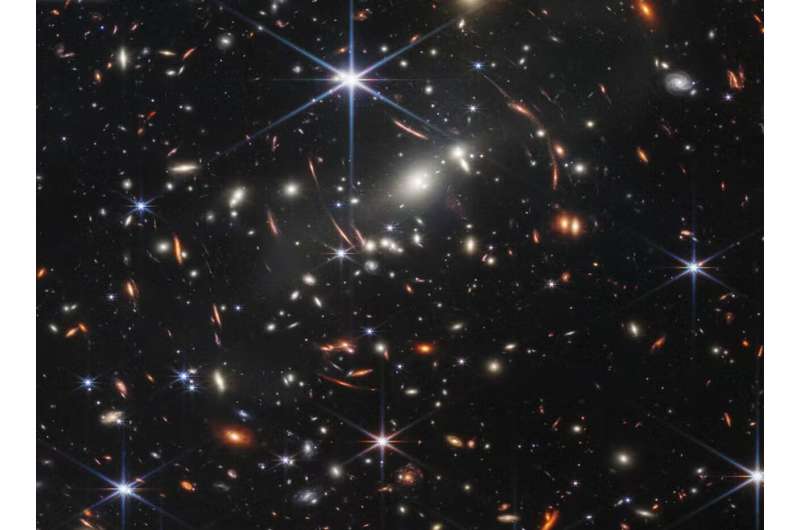"If you held a grain of sand on the tip of your finger at arm's length, that is the part of the universe that you're seeing—just one little speck of the universe," Nelson said.
Webb is the successor to the Hubble Space Telescope, which transformed science's understanding of the vastness of the universe. One of Hubble's most famous images, the eXtreme Deep Field, shows flecks of light representing some 5,500 galaxies, the faintest of which enable us to look back in time 13.2 billion years.
Webb allows astronomers to zoom in on Hubble's faintest flecks.
"It's an emotional moment when you see nature suddenly releasing some of its secrets," said Thomas Zurbuchen, associate administrator for NASA's Science Mission Directorate. "It's not an image. It's a new worldview. You're going to see nature giving up secrets that have been there for many, many decades, centuries, millennia."
Webb can, quite literally, see galaxies far, far away as they were long, long ago—just a few hundred million years after the big bang. It intercepts light in the infrared part of the spectrum, whose wavelengths are too long to be visible to the human eye.
Built at Northrop Grumman's Space Park in Redondo Beach, California, Webb launched on Christmas Day from French Guiana. Its destination was L2, scientific shorthand for the second LaGrange point roughly 930,000 miles from Earth. It's one of five places where the gravitational forces of the sun and the Earth are in balance, allowing Webb to remain a fixed distance from our planet.
It took nearly a month for the telescope to get there. Then the telescope slowly and deliberately unfolded itself over the course of two weeks.
An intricate system of latches, cables and pins released a five-layer sunshield about the size of a tennis court. Once that was in place the telescope's 18 hexagonal mirrors swung into place, creating a honeycomb-like structure 21 feet across. The process wouldn't have seemed out of place in an episode of "Transformers." (Indeed, NASA released a short video about Webb featuring Peter Cullen, the actor who voiced Optimus Prime in the original 1980s cartoon.)
Each mirror is coated in 100 nanometers of gold to enhance its ability to reflect infrared light. The mirrors were carefully aligned by focusing on a star with the unwieldy name 2MASS J17554042+6551277. The test image, released to the public in March, showed a brilliant star that appeared to radiate light from six points, a feature of the telescope's hexagonal mirrors.
But the background caught scientists' attention: Behind the star were countless flecks of light, each representing a galaxy billions of years old.
It was a tantalizing peek at the telescope's capabilities.
Hubble, launched in 1990, has offered unprecedented insight into the cosmos during its decades of service. Its observations have helped scientists determine the age of the universe and the rate of its expansion, along with discovering black holes, obscure moons and exoplanets.
But Webb is exponentially more powerful. Its mirror is six times larger than Hubble's, meaning it can collect far more light and look farther back in time. It also has far greater capabilities to study infrared light.
Webb wouldn't work if it were where Hubble is. The newer telescope is so much more sensitive that it would be overwhelmed by light and heat from the Earth, moon and sun. But its distance also means that it's too far away to be repaired manually by spacewalking astronauts, as Hubble has been five times since its launch.
Hubble had been in the sky for less than a decade when NASA began talking about the technology that would eventually replace it. Construction of the new telescope, named for NASA's second administrator, began in 2004 with a $1 billion budget and targeted launch date of 2010.
But the budget and timeline expanded nearly as fast as the universe it was meant to explore.
The team didn't just have to ensure the materials and technologies on the telescope would work properly once shot into space. In many cases, given the pathbreaking nature of the device, they also had to invent those materials from scratch.
The segmented cryogenic mirrors, the five-layer sunshield, the microshutters that capture infrared light—all of it had to first be imagined and lab-tested before being manufactured for use on the telescope.
Its soaring costs ate into budgets for NASA's other projects. In 2011, Congress floated a bill to kill the project entirely. If a risk this big failed, "the progress of astronomy could be set back by a generation," the journal Nature warned in a 2010.
©2022 Los Angeles Times.
Distributed by Tribune Content Agency, LLC.



